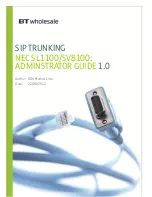
Conditions
•
The availability of this feature is dependent on the contract with the telephone company.
•
CLIP/COLP features comply with the following European Telecommunication Standard (ETS)
specifications:
–
ETS 300 092 Calling Line Identification Presentation (CLIP) supplementary service.
–
ETS 300 097 Connected Line Identification Presentation (COLP) supplementary service.
•
CLIR/COLR features comply with the following European Telecommunication Standard (ETS)
specifications:
–
ETS 300 093 Calling Line Identification Restriction (CLIR) supplementary service.
–
ETS 300 098 Connected Line Identification Restriction (COLR) supplementary service.
•
The CLIP/COLP number for the connected ISDN port can be used for the ISDN terminal devices which
cannot be assigned their own CLIP/COLP number, such as a doorphone.
•
COLP/CLIR/COLR Assignment for Each Port
Each service can be enabled or disabled on each ISDN port of the PBX.
•
CLIR Button and COLR Button
It is possible to switch between CLIP and CLIR by pressing the CLIR button, and COLP and COLR by
pressing the COLR button. A flexible button can be customised as the CLIR or COLR button.
•
The CLIP/COLP number must match the telephone number provided by the telephone company.
Otherwise it will be ignored or replaced by another number.
•
When using a private network, the extension number assigned for each extension through system
programming is sent for CLIP/COLP. (
®
4.3.4.2 Calling/Connected Line Identification Presentation (CLIP/
COLP) and Calling/Connected Name Identification Presentation (CNIP/CONP)—by QSIG)
•
When forwarding calls to a public trunk, system programming selects whether the CLIP number of the
calling party or of the forwarding extension is sent to the forward destination.
However, if the call is transferred to another PBX via a private network from a VPS or a UM, the CLIP
number of the calling party is always sent, regardless of system programming.
PC Programming Manual References
9.26 PBX Configuration—[1-1] Configuration—Slot—Port Property - BRI Port
COLP, CLIR, COLR, CNIP, CONP, CNIR, CONR, CF (Rerouting), CT,
9.27 PBX Configuration—[1-1] Configuration—Slot—Port Property - PRI Port
COLP, CLIR, COLR, CNIP, CONP, CNIR, CONR, CF (Rerouting), CT,
CCBS, AOC-D, AOC-E, E911, 3PTY
10.6.1 PBX Configuration—[2-6-1] System—Numbering Plan—Main—Features
Switch CLIP of CO Line / Extension
10.9 PBX Configuration—[2-9] System—System Options—Option 4
Send CLIP of CO Caller—when call is transferred to CO (CLIP of Held Party)
Send CLIP of CO Caller—when call is forwarded to CO
Send CLIP of Extension Caller—when call is forwarded to CO
Feature Guide
387
4.1.2 Integrated Services Digital Network (ISDN) Service Features
Summary of Contents for KX-NS500
Page 14: ...14 Feature Guide Table of Contents...
Page 15: ...Section 1 For Your Safety Feature Guide 15...
Page 18: ...18 Feature Guide 1 1 1 For Your Safety...
Page 19: ...Section 2 Call Handling Features Feature Guide 19...
Page 57: ...632 Maximum Number of Agents Feature Guide 57 2 2 2 Incoming Call Distribution Group Features...
Page 107: ...User Manual References 1 2 1 Basic Calling Feature Guide 107 2 5 4 Trunk Call Features...
Page 193: ...User Manual References 1 4 2 Holding a Call Feature Guide 193 2 13 1 Call Hold...
Page 324: ...324 Feature Guide 2 30 2 Outgoing Message OGM...
Page 325: ...Section 3 Unified Messaging System Feature Guide 325...
Page 375: ...Section 4 Network Features Feature Guide 375...
Page 464: ...464 Feature Guide 4 3 6 Network ICD Group...
Page 465: ...Section 5 System Configuration and Administration Features Feature Guide 465...
Page 560: ...560 Feature Guide 5 6 7 PING Confirmation...
Page 561: ...Section 6 Appendix Feature Guide 561...
Page 578: ...578 Feature Guide 6 5 2 PFMPR Software File Version 004 2xxxx...
Page 579: ...Feature Guide 579 Notes...








































